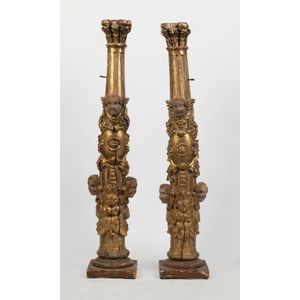Gilded figural columns with Corinthian capitals and winged cupids
A pair of relief carved and gilded figural columns, probably Italian, late 18th century, each with a Corinthian capital and fluted column adorned with winged cupids, raised on a stepped, socles, 153 cm high, 29.5 x 29.5 cm at base
You must be a subscriber, and be logged in to view price and dealer details.
Subscribe Now to view actual auction price for this item
When you subscribe, you have the option of setting the currency in which to display prices to $Au, $US, $NZ or Stg.
This item has been sold, and the description, image and price are for reference purposes only.
- Capital - In architecture, a capital is the topmost member of a column, pilaster, or pier, which sits on top of the shaft and supports the entablature or architrave above it. The capital is typically the most ornate and decorative element of the column, and it can take many different forms depending on the architectural style of the building.
In classical architecture, the most common types of capitals are the Doric, Ionic, and Corinthian. Doric capitals are simple and have a circular shape with a flat top and bottom. Ionic capitals have a more elaborate design with scrolls or volutes (spiral shapes) at the top, and Corinthian capitals are the most decorative, with elaborate carvings of acanthus leaves and other motifs.
In other architectural styles, capitals can take many different forms, such as the bell-shaped capitals of Gothic architecture or the foliate designs of the Romanesque period. The capital is one of the most important architectural element in a building, it is the one that gives the most character and identity to the building. - Gilding - Gilding is a method of ornamentation whereby a thin sheet of gold metal is applied to items made of wood, leather, ceramics, glass and silver for decorative purposes.
For furniture including mirrors, the sheet of gold is usually applied over a coating of gesso. Gesso is a mixture of plaster of Paris and gypsum mixed with water and then applied to the carved wooden frames of mirrors and picture frames as a base for applying the gold leaf. After numerous coats of gesso have been applied, allowed to dry and then sanded a coat of "bole", a usually red coloured mixture of clay and glue is brushed on and allowed to dry, after which the gold leaf is applied. Over time parts of the gilding will rub off so the base colour can be seen. In water gilding, this was generally a blue colour, while in oil gilding, the under layer was often yellow. In Victorian times, gilders frequently used red as a pigment beneath the gold leaf.
Metal was often gilded by a process known as fire gilding. Gold mixed with mercury was applied and heated, causing the mercury to evaporate, the long-term effect of which was to kill or disable the craftsman or woman from mercury poisoning. The pursuit of beauty has claimed many victims, not the least of which were the artists who made those pieces so highly sought after today.
This item has been included into following indexes:
